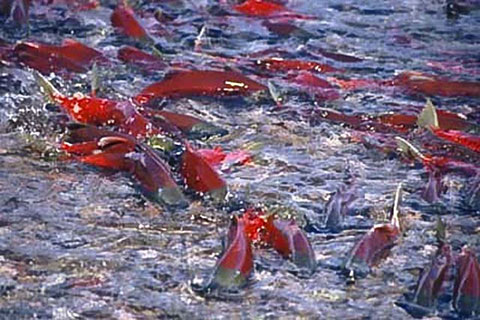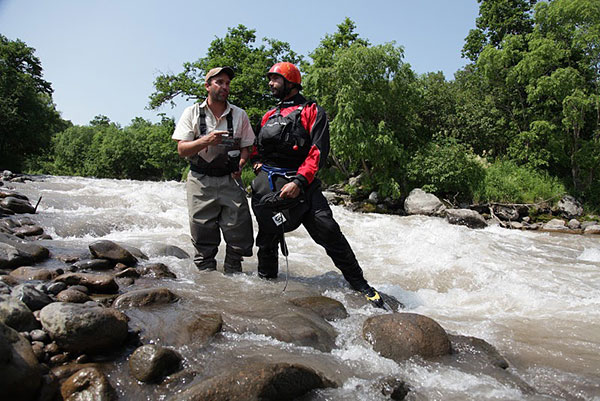Water Quality Sampling Helps Information Gathering
In Russia’s Far East lies the 1,250 km (780 mile) Kamchatka Peninsula. Situated between the Pacific Ocean and the Sea of Okhotsk, Kamchatka is home to Steller’s sea-eagles, brown bears, World Heritage List volcanoes, and a remarkable amount of Pacific salmon (genus Oncorhynchus) that are being studied, protected and even filmed for television.
Kamchatka may contain the world’s greatest diversity of salmonids including chinook, chum, coho, seema, pink, and sockeye salmon. Rainbow trout and dolly varden char are also highly abundant. Biologists estimate at least 20% of all wild Pacific salmon originates in Kamchatka.
The life of a salmon is far from easy as a fish life goes. Millions of fry, roughly five inches long after a few months of growth, have to navigate close to a hundred miles to the sea. For instance, salmon born on the Bystraya River swim to its confluence with the larger Bolshaya River. If they are lucky enough to survive this journey, they must now metamorphose into a smolt capable of living in saltwater environments in the Sea of Okhotsk. For a period of anywhere from 2-5 years, they migrate out into the vast Pacific Ocean traveling upwards of thousands of miles. Along the way these salmon face predation, competition, pollution, and the ever-present fishermen with drift nets or poachers in search of profitable caviar.
The life of an anadromous fish affords it the ability to grow large and strong in a relatively short time period. During this time, they also reach sexual maturity, which triggers the journey back to where it all started - many miles back up the rivers. Once they reach the estuary, they will start the arduous task of ascending upstream and making decisions to swim into smaller and smaller branches of the rivers until finally reaching the shallow riffles in the small tributaries from where they originated.
This journey in the Bolshaya River can be particularly hazardous where poaching (mainly caviar) and over-catching by companies licensed to fish legally frequently exceed their quotas without much oversight. Poaching is estimated to be on the scale of 120 million pounds of salmon annually, which can have catastrophic consequences on a species already facing an uphill battle, literally, to survive.
The situation is different on the Kol River, which, with its absence of streamside roads, affords limited access for poachers or fishermen. The habitat on the Kol is nearly ideal for salmon. The salmon run includes over seven million fish returning to spawn. The fish fill the river channel so fully that some sections block the view to the river bottom. The Kol also has the world’s first whole-basin refuge for the conservation of Pacific salmon - the Kol-Kekhta Regional Experimental Salmon Reserve.
Research
Along the Kol’s north bank is the Kol River Biostation established for the sole purpose of serving as a binational research station between Russia and the U.S. Researchers are studying the dynamics of the Kol ecosystem and addressing the question of the importance of the salmon to the health of the entire river’s ecosystem.
While there is no question to the importance of the healthy ecosystem on the salmon, do the salmon themselves add to the overall health of the ecosystem and how? Research shows that the migrating salmon, who subsequently perish after mating, bring back much needed nutrients such as nitrogen and phosphorus. As they mate, die, and decompose, their bodies release these nutrients back to the upper-reach headwaters. Willow and cottonwood trees use these nutrients, allowing them to grow, flourish, and subsequently give up their leaves to the river for microbes and insects to survive.
This research is proving useful in understanding the symbiotic relationship in Kamchatka. The Wild Salmon Center (WSC) and its partners are encouraging the Kamchatka government in an ambitious effort to add five additional protected areas. Each area would encompass the entire basin, or watershed, and not just the rivers. This project would make the largest single project devoted primarily to protecting and nurturing wild salmon.
Protection
Protecting and nurturing not only salmon but also numerous other species has been in Megafishes Project leader Dr. Zeb Hogan’s blood for years (@ZebHogan). Says Hogan, “I’ve been interested in fish, rivers, and streams as long as I can remember. I love research, science, and exploration. These projects allow me to combine all of those things and to convey my excitement to others, who I hope will take action to protect these amazing places and animals.”
Hogan travels to many remote places in an effort to save critically endangered fish and the livelihood of the people who share their habitats. He earned a degree from the University of Arizona and later became a visiting Fulbright student at Thailand’s Chiang Mai University. Upon returning to the U.S., he earned a National Science Foundation sponsored Ph.D. in ecology from UC Davis and is currently a fellow at the University of Wisconsin and the World Wildlife Fund.
Megafish and Monster Fish
The MegaFishes Project spanned six continents with expeditions to study 14 of the most diverse freshwater systems—ecological treasures including World Heritage Sites and United Nations Environment Program Biodiversity Hotspots. Research occurred in Asia, Australia, Africa, Europe, and the Americas during a 4-year span which started in the pilot year 2006.

Dr. Hogan worked with more than one hundred scientists in 17 countries to accomplish a conservation assessment of all species of giant freshwater fish, including gathering information about the life history, population status, geographic range, and threats associated with each species. Also included was the identification of the world’s largest freshwater fish along with local, national, and global awareness-raising and education about the importance of freshwater conservation, including increased visibility for freshwater science.
The Megafishes Project yielded tangible results. Hogan’s work with the governments of Cambodia, Thailand, and Laos made the capture of the Mekong giant catfish illegal in those countries. The project also teamed with the Cambodian Department of Fisheries and the Mekong Wetland Biodiversity Program to create one of the world’s first freshwater conservation concessions—a special fishing area in the Tonle Sap River aimed at protecting some of the world’s largest freshwater fish species, including the giant stingray.
Hogan’s work on the Megafishes Project, in conjunction with the National Geographic Society and World Wildlife Fund, led to his work on Hooked which currently airs on the National Geographic Channel. The success of Hooked led Dr. Hogan to now host a 13-part series called Monster Fish, which also airs on the NatGeo Channel.
During his work on Monster Fish: Kamchatka Salmon, Dr. Hogan included some research on water quality data during his time in the Kamchatka Peninsula. In an effort to understand the abundance of Pacific salmon in this region, gathering data on water quality conditions further added to the scientific data gathered as part of their research.
The YSI Professional Plus (now ProQuatro) multiparameter handheld instrument was used primarily on the Zhupanova River, situated in the south-eastern Kamchatka Peninsula, to gather valuable water quality data. Data gathered included temperature, dissolved oxygen, pH, nitrate, and conductivity. In addition, depth measurements were recorded.
The YSI ProQuatro instrument is capable of measuring several key parameters at the same time and allows data to be logged into the instruments’ file structure. Data download is simplified with the Data Manager Desktop software included with the instrument. It was an ideal instrument in the Kamchatka Peninsula because the meter is designed for rugged fieldwork and includes a waterproof rating, durable military spec connectors, and 1-meter drop test specs.
Of his travels, Hogan notes, “It’s a real chance to make discoveries about local biodiversity, compare ecology of different river systems, provide new observations on animal behavior, and perhaps discover new species.”
There is no doubt, the salmon of Kamchatka would thank him if they could.

Additional Blog Posts of Interest:
How the Pro Plus Water Quality Meter Saves Time When There's No Time to Spare
Water Quality Study Near Port-Au-Prince, Haiti
Monitoring the Effects of a Forest Invader with a Water Quality Meter
Fish Diversity, Nutrient Recycling | A Study in Dissolved Oxygen